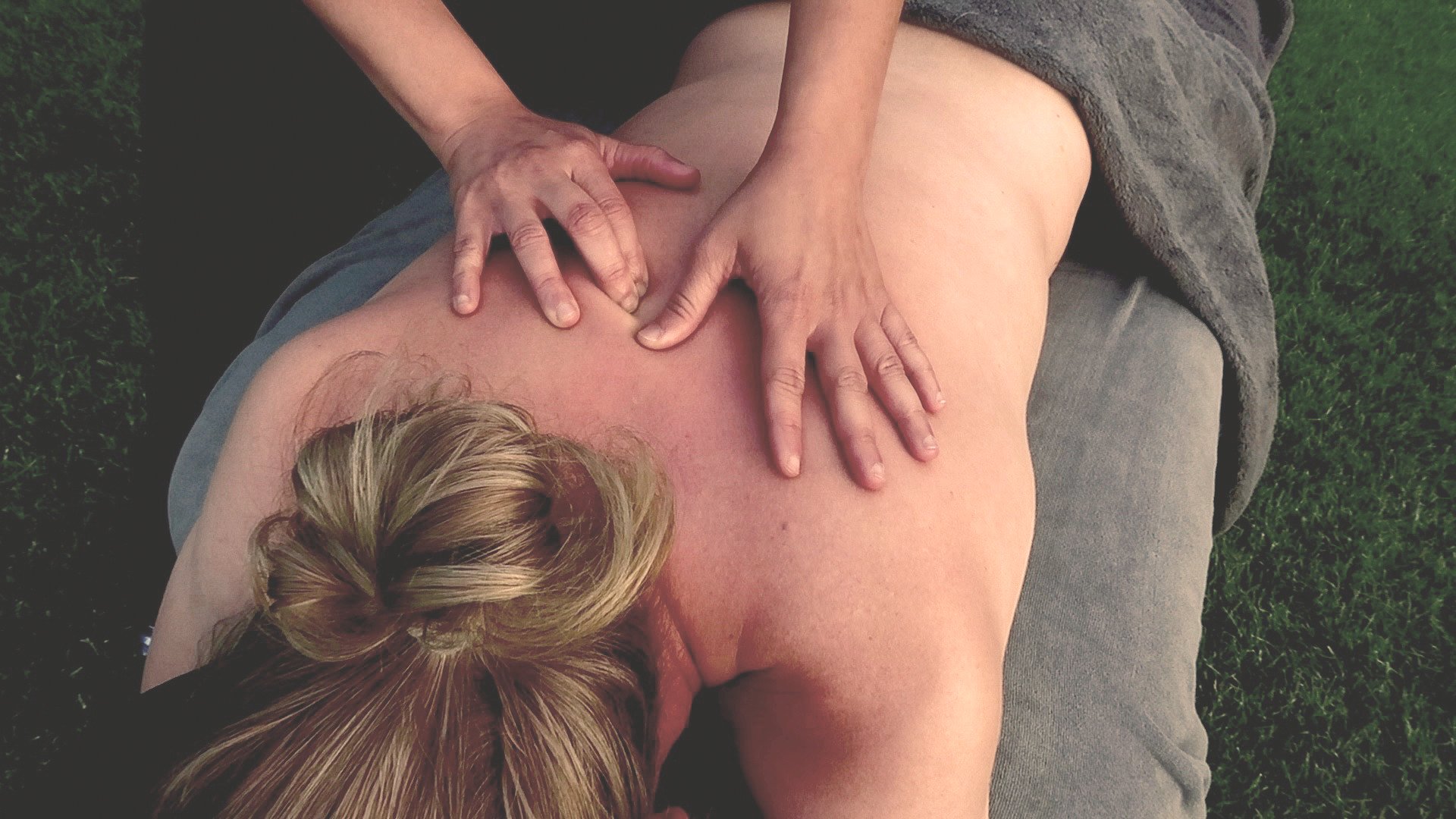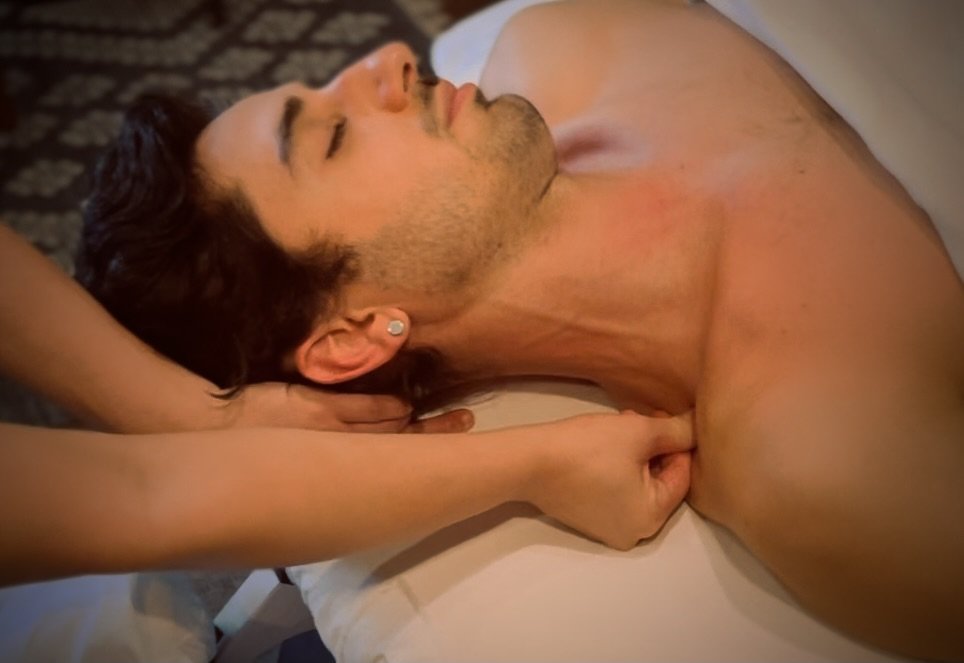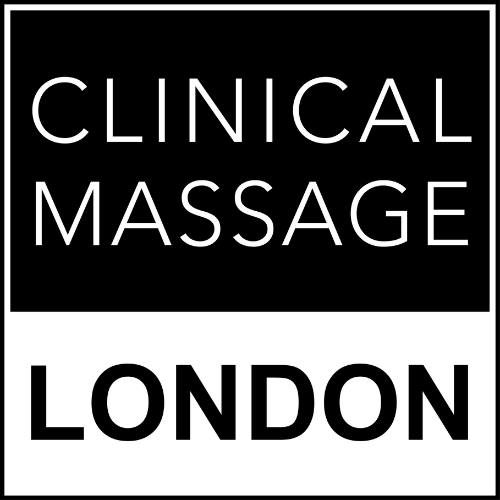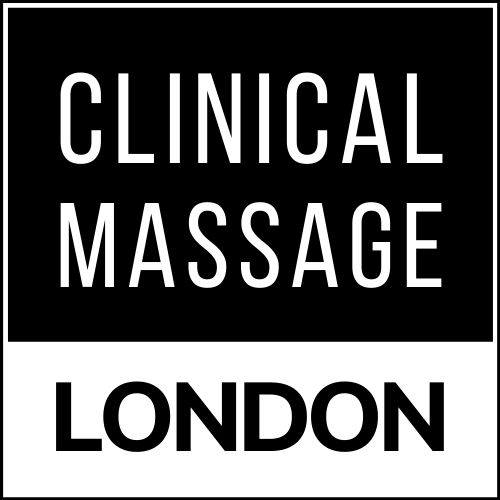
Trigger Point Therapy
What is Trigger Point Therapy?
Trigger point therapy is technique often used by clinical and sports massage therapists to treat myofascial trigger points, which are tender, hyper-irritable spots that can occur within muscle fibres, and a common cause of muscular pain complaints.
Written By Natalie Heng
Clinical & Sports Massage Therapist (BTEC 6, SMA Reg) | Ex-Science Writer | BSc (Hons)
The good news is that if a trigger point is what’s causing your pain, massage can be very effective method of alleviating it.
There are many techniques that can be used to address trigger points, and if someone is exhibiting a distinctive pain pattern, this can make finding the root cause of their pain even easier.
Commonly, a static compression is applied on the affected area until the tissue relaxed and there is a reduction in pain.
One particular theory of what causes a ‘trigger point’ involves changes in the local biochemistry of the cells (scroll down for more on this below).
The blanching effect of applied compression is thought to squeeze blood out of the tissue, so when pressure is released, blood supply floods back into the local area.
This is in turn, thought to enhance availability of oxygen, nutrients and other metabolites, helping to restore balance to the local biochemical environment of the cell.
At Clinical Massage London, trigger Point work is always incorporated into a treatment if needed.
If we find a trigger point, we work on it using clear client communication, to establish boundaries of ‘good’ pain.
The most effective treatments are often intense, but also immensely satisfying.

What Are The Symptoms Of A Trigger Point?
They are tender on palpation, and when active, can also be associated with a predictable pattern of referred pain.
This sensation of ‘pain’ can radiate outwards from the tender point or may be felt in other parts of the body, and has been described as ‘deep’, ‘diffuse’, ‘burning’, ‘tightening’ or ‘pressing pain’.
The area around the trigger point may also associated with a feeling of ‘numbness’, ‘coldness’, ‘weakness’, ‘stiffness’ or ‘fatigue’.
These hyper-contracted bands of muscle fibre can even occur within a muscle that may not otherwise appear to have an abnormally high tone.
In fact, trigger points can cause the host muscle to test as weak, and can produce a loss of range of motion in the joint it attaches to.
What Causes Trigger Points?
Trigger points' are thought to arise due to continuous low load activities.
Think sitting slouched at a desk clicking on a mouse all day - the kind of activities likely to be associated with lots of repetitive, specific movements, or held positions.
Research has shown that trigger points are more common in individuals who perform repetitive low load muscle exertions as part of their daily activity.
Suboptimal postures that are a source of constant low load activity are also thought to play a role in the development of trigger points.
There is a good chance that the nonspecific low back, neck or shoulder pain you come home with may be related to trigger points. The good news?
Trigger point-related pain can often be relieved by trigger point therapy.
But What Are Trigger Points, In A Physical Sense?
I mean, what is it about these low load activities that actually causes them? Though there are various theories - most point to changes in the local biochemistry of tissues that house the ‘trigger point’.
The Integrated Trigger Point Hypothesis
One popular theory known as the ‘integrated trigger point hypothesis’ points to the development of a localised group of muscle fibre contractures. This is where a group of individual muscle fibers are sustained by abnormal chemistry that develops at the point where they are innervated by their motor neuron (which sends motor impulses from your brain and spinal cord to your muscles). Sometimes a strain, overuse, or some other form of mechanical stress within a muscle region can trigger an excessive release of calcium ions in the area, which in turn triggers an excessive release of a powerful neurotransmitter known as acetylcholine.
Trigger Points are Associated with the Development of a ‘Metabolic Crisis’
The continuous flow of this biochemical messenger then causes the contractile units within the immediate area around the motor end plate of the motor neuron to slide into a fully shortened position. The taut tissue in turn compresses surrounding blood vessels, which is thereby thought to interrupt blood flow (referred to as ‘ischemia’), reducing cellular levels of oxygen (hypoxia) and nutrients in this localised area. These events are thought to trigger a what has been dubbed a ‘metabolic crises’. An increase in tissue acidity, calcium ions and chemicals, proteins and neurotransmitters related to inflammation and pain follow suit. All this leads to the increased sensitivity to pressure and pain within the localised region within the muscle we refer to as the ‘trigger point’.
How Are Trigger Points Treated?
All treatments start with a brief consultation where your massage therapist will ask you to talk about your pain. The answers to these questions provide starting off points for how to approach the treatment, and may offer clues on whether the pain is trigger point related.
Firstly, you will be asked to describe the quality of your pain sensation.
Pain that is deep and achy, and triggered by moving too little or doing too much for example, are characteristic of trigger points.
If the sensations described are sharp, electric or tingling on the other hand, the pain may be related to other causes - such as nerve root irritation or compression syndromes.
Distinguishing between the sensations and possible causes will help manage expectations for treatment outcomes, and allow your therapist to adjust their treatment strategy accordingly.
The second question will be about the location of your pain.
Where you feel the sensations can offer important clues about which muscles to target, because trigger points in different muscles are associated with specific pain patterns.
Sometimes, these pain patterns may overlap - for example trigger points in the gluteal muscles can refer into the low back, as can trigger points in the erector spinae and quadratus lumborum muscles.
By identifying possible sources, your therapist will know what regions and areas to cover in in your treatment. Often, the best strategy is to simply cover all the bases and respond to what we find during the treatment.
The third question will be about recent activities, and what makes the pain better or worse?
Asking about when the pain started, what you did differently around that time, and activities that make the pain better or worse can be useful sources of information to guide us in how we approach the treatment.
Let me give you a scenario for what one of these fact-finding missions might look like, and how it translates into a strategy for treatment:
Someone comes in with a deep ache that starts at the low back that radiates into the buttock and wraps around the side of the hips - a common pain pattern for trigger points in the Quadratus Lumborum muscle, which laterally flexes, extends and stabilises the trunk.
Trigger points in the Quadratus Lumborum can commonly occur in response to:
Unaccustomed eccentric loading of the muscle when awkwardly lifting heavy objects, like a suitcase on holiday or your three year old niece
Quick bends or twisting movements, like a weekend of golf
Prolonged awkward postures from twisting or leaning to one side, like reading on your armchair or having to work with two screens at work.
Your therapist will check in with you during treatment to keep the intensity around a 6 or 7 — enough to feel the effectiveness of the work, but never so much that your body tightens or braces in response.
Many people describe the sensation as a “good pain,” and even enjoy the deep pressure, as it often brings a sense of relief. By breathing through the intensity, most clients find that the tight muscle fibres begin to release, and the discomfort softens into relaxation.
Trigger point therapy is always guided by good client communication, ensuring the experience is tailored to your comfort level while still being effective. You are always in control.
This work may then be followed by elongation (stretching) or the tissues to help ‘reset’ the appropriate relationship of actin and myosin filaments within the tissues around the site.
Through your pre-treatment consultation, your therapist finds out you've just been moving house and bending down to lift and carry heavy boxes. Your pain comes and goes, but movement seems to make it feel better.
A a result of the consultation, your therapist suspects the ache that you are experiencing may be related to Quadratus Lumborum.
There are also other muscles in the area with overlapping pain patterns which may also involved in these movements, such as the Gluteus Medius and Erector Spinae.
So they suggest incorporating general work to warm up and relax the area, including myofascial release, deep tissue massage, trigger point therapy and neuromuscular stretching around the back, low back, and hips.
This minimises the chances that something will be ‘missed’ during treatment, and working broadly around the area of focus is always a good idea as tension is often present due to bracing around an area of pain.
What does the actual ’Trigger Point Therapy’ look like?
Trigger point work entails localised compression of between 12-15 seconds on the tender point, or until the intense localised as well as referred sensation has decreased. Sometimes this work can elicit a 'melting' sensation of the tissues, followed by a sense of relief.
Trigger point therapy can feel intense, but it should never feel overwhelming or unbearable. At Clinical Massage London, our therapists work closely with you to ensure the pressure stays within a comfortable range. We use a pain scale of 1 to 10, where:
1 = no pain or just light pressure
10 = unbearable intensity
7 = the maximum threshold of acceptable pressure
Are you in pain?
Book in for some deeply therapeutic clinical and sports massage at Clinical Massage London designed to soothe, relax and restore your body!
At Clinical Massage London, we’ve helped hundreds of clients move better and feel better in their bodies.
Trigger Point Therapy
Frequently Asked Questions (FAQ)
-
Trigger point therapy is a clinical massage technique used to relieve muscle pain and stiffness by targeting active or latent trigger points within the muscle known. These trigger points can cause localised or referred pain, limiting mobility and function.
-
Trigger points are hyperirritable spots in skeletal muscle that feel like small, tight ‘knots’. They can be tender to touch and may cause referred pain—pain that radiates to another part of the body.
-
They are tender on palpation, and when active, can also be associated with a predictable pattern of referred pain.
This sensation of ‘pain’ can radiate outwards from the tender point or may be felt in other parts of the body, and has been described as ‘deep’, ‘diffuse’, ‘burning’, ‘tightening’ or ‘pressing pain’.
The area around the trigger point may also associated with a feeling of ‘numbness’, ‘coldness’, ‘weakness’, ‘stiffness’ or ‘fatigue’.
May cause the host muscle to test as weak, and can produce a loss of range of motion in the joint it attaches to.
-
One theory is that some form of mechanical stress within a muscle region can trigger an excessive release of calcium ions in the area, which in turn triggers an excessive release of a powerful neurotransmitter known as acetylcholine.
Trigger Points are Associated with the Development of a ‘Metabolic Crisis’, where the continuous flow of this biochemical messenger then causes the contractile units within the immediate area around the motor end plate of the motor neuron to slide into a fully shortened position.
The taut tissue in turn compresses surrounding blood vessels, which is thereby thought to interrupt blood flow (referred to as ‘ischemia’), reducing cellular levels of oxygen (hypoxia) and nutrients in this localised area.
These events are thought to trigger what has been dubbed a ‘metabolic crises’. An increase in tissue acidity, calcium ions and chemicals, proteins and neurotransmitters related to inflammation and pain follow suit.
All this leads to the increased sensitivity to pressure and pain within the localised region within the muscle we refer to as the ‘trigger point’.
-
Trigger point therapy can feel intense, but it should never feel overwhelming or unbearable. At Clinical Massage London, our therapists work closely with you to ensure the pressure stays within a comfortable range. We use a pain scale of 1 to 10, where:
1 = no pain or just light pressure
10 = unbearable intensity
7 = the maximum threshold of acceptable pressure
Your therapist will check in with you during treatment to keep the intensity around a 6 or 7 — enough to feel the effectiveness of the work, but never so much that your body tightens or braces in response.
Many people describe the sensation as a “good pain,” and even enjoy the deep pressure, as it often brings a sense of relief. By breathing through the intensity, most clients find that the tight muscle fibres begin to release, and the discomfort softens into relaxation.
Trigger point therapy is always guided by good client communication, ensuring the experience is tailored to your comfort level while still being effective. You are always in control.
-
At Clinical Massage London, we offer expert trigger point therapy as part of our clinical and sports massage treatments. Whether you’re dealing with hip tightness, back pain, or just want to move more freely, our skilled therapists are here to help.
Book a session online today and start your journey toward pain relief and improved mobility.







